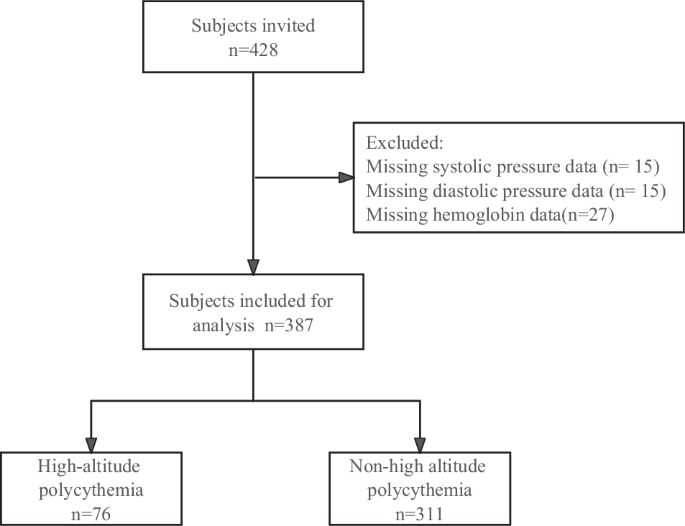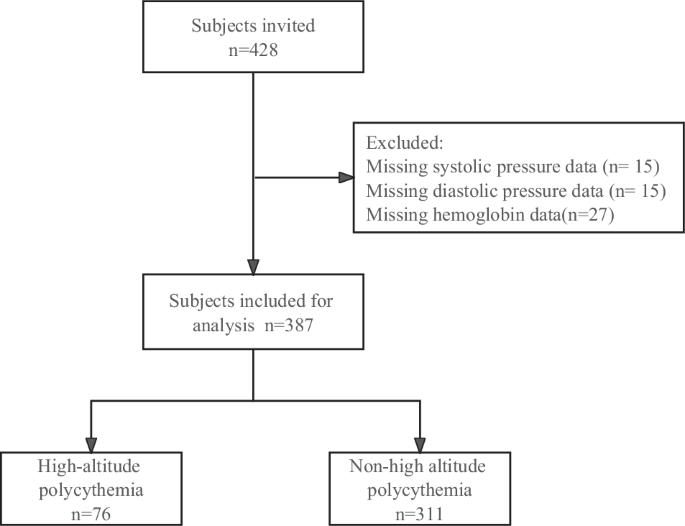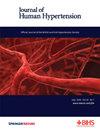高海拔多血症与高血压之间的关系:对西藏超高海拔地区成年人的横断面研究。
IF 2.7
4区 医学
Q2 PERIPHERAL VASCULAR DISEASE
引用次数: 0
摘要
该研究旨在评估居住在海拔4700米高原上的安多县成年人的高海拔多血症与高血压之间的关联。共有 387 人参加了 2021 年 4 月至 5 月间进行的横断面调查。调查采用访谈、体格检查和实验室检测等方式收集所有受试者的信息。采用多变量逻辑回归模型评估了高海拔多血症与高血压之间的关系。387 名受试者的平均年龄为 32.6 ± 6.3 岁。其中 260 人(67%)为男性。高血压的总体患病率为 27.1%(57/380)。按性别分层,女性患病率为 12.6%(16/127),男性患病率为 34.2%(89/260)。高海拔多血细胞症的总发病率为 19.6%(76/387)。按性别分层,男性发病率为 26.2%(68/260),女性为 6.3%(8/127)。在逻辑回归分析中,我们发现血红蛋白升高到 10 克/升的参与者患高血压的风险比正常人高 26%(调整后的比值比 [OR],1.26;95% 置信区间 [CI],1.11-1.44)。此外,与非高海拔多血细胞症相比,高海拔多血细胞症大大增加了高血压的风险(OR,3.01;95% CI,1.66-5.44,P本文章由计算机程序翻译,如有差异,请以英文原文为准。


Association between high-altitude polycythemia and hypertension: a cross-sectional study in adults at Tibetan ultrahigh altitudes
The study aimed to evaluate the association between high-altitude polycythemia and hypertension in adults residing on Anduo County’s plateau, which is located 4700 meters above sea level. A total of 387 individuals participated in the cross-sectional survey conducted between April and May of 2021. Interviews, physical inspections, and laboratory tests were employed to gather information about all of the subjects. The association between high-altitude polycythemia and hypertension was assessed using multivariable logistic regression models. The average age of the 387 participants was 32.6 ± 6.3 years. Of these participants, 260 (67%) were male. The overall prevalence of hypertension was 27.1% (57/380). When stratified by gender, the prevalence was 12.6% (16/127) in females and 34.2% (89/260) in males. The overall prevalence of high-altitude polycythemia was 19.6% (76/387). When stratified by gender, the prevalence was 26.2% (68/260) in males and 6.3% (8/127) in females. During logistic regression analysis, we found that participants with elevated hemoglobin per 10 g/L had a 26% greater risk of hypertension (adjusting for odds ratio [OR], 1.26; 95% confidence interval [CI], 1.11–1.44). Additionally, high-altitude polycythemia greatly increased the risk of hypertension in comparison to non-high-altitude polycythemia (OR, 3.01; 95% CI, 1.66–5.44, P < 0.001). The consistency of the results was further demonstrated by stratified and interaction analyses, showing that Hans individuals had a higher risk of hypertension. High-altitude polycythemia is positively associated with hypertension in adults residing at Tibetan ultrahigh altitudes. The results of the investigation may aid in the planning of future research and guide the development of targeted healthcare practices for high-altitude populations, particularly among Han Chinese residents of the Tibetan Plateau.
求助全文
通过发布文献求助,成功后即可免费获取论文全文。
去求助
来源期刊

Journal of Human Hypertension
医学-外周血管病
CiteScore
5.20
自引率
3.70%
发文量
126
审稿时长
6-12 weeks
期刊介绍:
Journal of Human Hypertension is published monthly and is of interest to health care professionals who deal with hypertension (specialists, internists, primary care physicians) and public health workers. We believe that our patients benefit from robust scientific data that are based on well conducted clinical trials. We also believe that basic sciences are the foundations on which we build our knowledge of clinical conditions and their management. Towards this end, although we are primarily a clinical based journal, we also welcome suitable basic sciences studies that promote our understanding of human hypertension.
The journal aims to perform the dual role of increasing knowledge in the field of high blood pressure as well as improving the standard of care of patients. The editors will consider for publication all suitable papers dealing directly or indirectly with clinical aspects of hypertension, including but not limited to epidemiology, pathophysiology, therapeutics and basic sciences involving human subjects or tissues. We also consider papers from all specialties such as ophthalmology, cardiology, nephrology, obstetrics and stroke medicine that deal with the various aspects of hypertension and its complications.
 求助内容:
求助内容: 应助结果提醒方式:
应助结果提醒方式:


